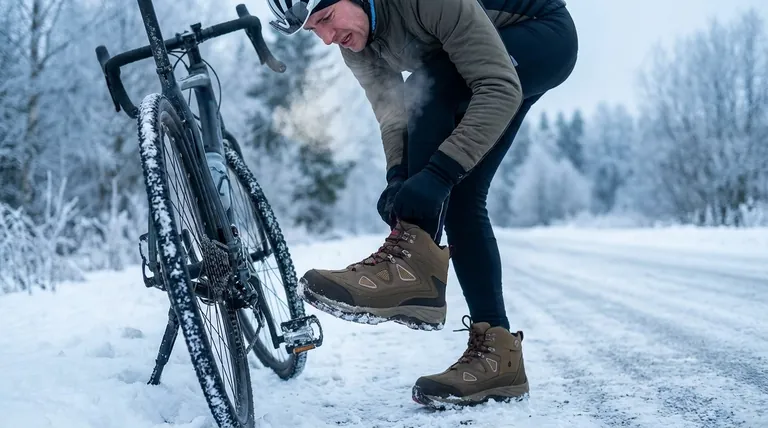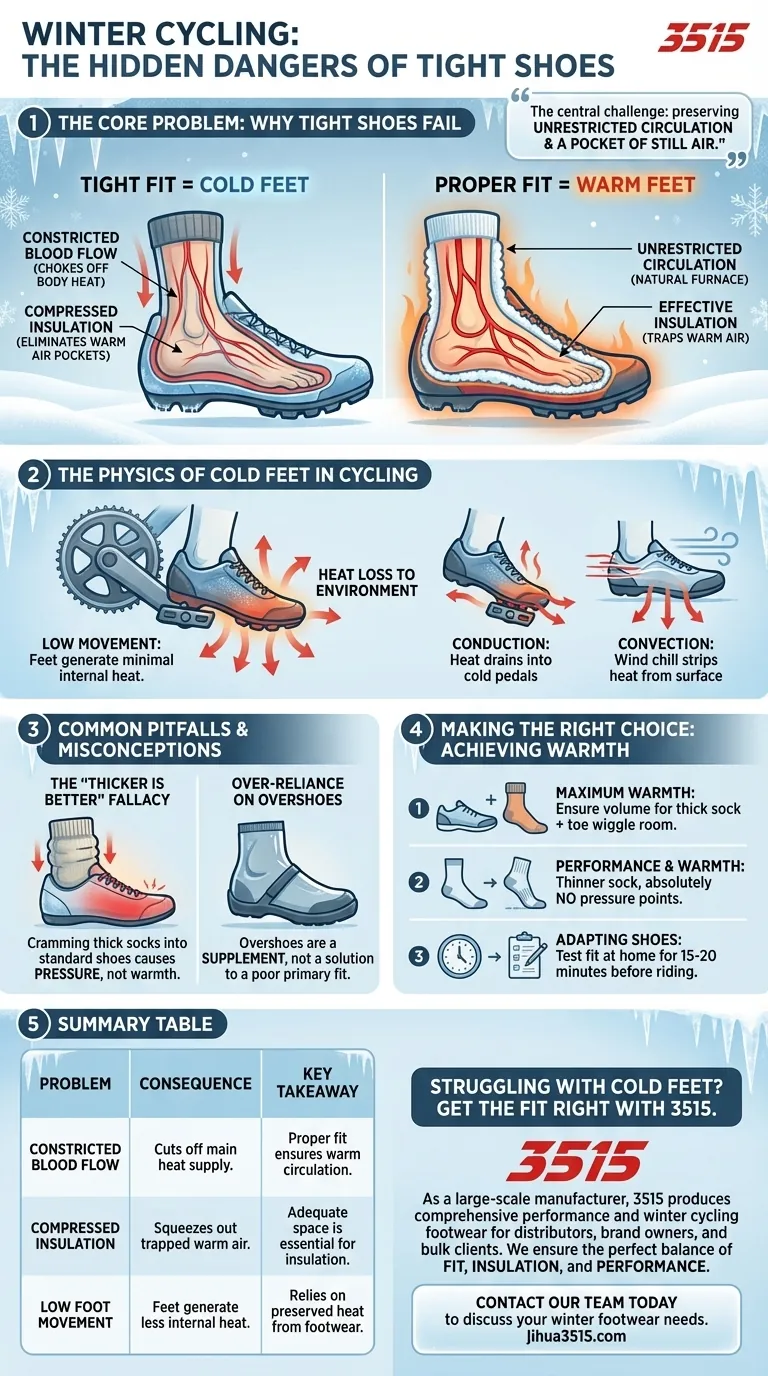At its core, wearing cycling shoes that are too tight in the winter is counterproductive because it creates two fundamental problems. It constricts blood flow, which is your body's primary heating mechanism, and it compresses the insulation in your socks, eliminating the trapped air that is essential for keeping you warm.
The central challenge of winter cycling footwear is not just adding insulation, but preserving the two things that generate and retain warmth: unrestricted blood circulation and the pocket of still air inside your shoe.

The Core Problem: How Tight Shoes Undermine Warmth
To understand why a tight fit is so detrimental, you need to see your foot as a delicate system. Disrupting one part of it causes the entire system to fail.
Constricted Blood Flow
Your circulatory system acts as a natural furnace. Warm blood flowing from your core is the most critical source of heat for your extremities, especially your feet.
When a shoe is too tight, it puts pressure on the blood vessels, effectively choking off this vital supply of warmth. No amount of external insulation can compensate for a lack of internal heating.
Compromised Insulation
Insulation, whether it's in a thick wool sock or a winter boot, works by trapping a layer of air. This trapped air is then warmed by your body heat and acts as a thermal barrier against the outside cold.
A shoe that is too tight compresses the sock's material, squeezing out this essential air pocket. A compressed sock loses nearly all of its insulating properties, becoming little more than a layer of fabric conducting cold.
The Physics of Cold Feet in Cycling
Your feet are uniquely vulnerable to cold during cycling, which makes proper shoe fit even more critical.
Why Cycling is Different
Unlike running or walking, cycling involves minimal foot movement and impact. This means your feet generate significantly less of their own heat through muscular activity.
With low internal heat generation, your feet become almost entirely dependent on preserved body heat and protection from the elements.
The Attack from Outside
Your feet are constantly losing heat to the environment through two main processes. Conduction drains warmth into your cold pedals, while convection (wind chill) strips heat away from the surface of your shoes.
A proper fit ensures your insulation can effectively fight this constant thermal assault.
Common Pitfalls and Misconceptions
Many well-intentioned strategies for warm feet fail because they overlook the core principles of space and circulation.
The "Thicker is Better" Fallacy
The most common mistake is cramming the thickest possible sock into a standard, form-fitting cycling shoe.
This approach directly causes the problems of constricted blood flow and compressed insulation. The result is a foot that feels tight, constricted, and, paradoxically, colder than it would with a thinner sock.
Over-reliance on Overshoes
Overshoes (or shoe covers) are an excellent defense against wind and moisture. However, they are a supplemental tool, not a solution to a poor primary fit.
An overshoe cannot fix a shoe that is already compressing your foot and killing your sock's insulation. It simply puts a shell over a system that has already failed internally.
Making the Right Choice for Your Goal
Achieving warm feet in winter requires thinking of your sock and shoe as a single system that must have adequate space.
- If your primary focus is maximum warmth for endurance rides: Ensure your winter shoe has enough volume to accommodate a thick winter sock while still allowing you to wiggle your toes freely.
- If your primary focus is maintaining performance with warmth: Opt for a slightly thinner sock but confirm there is absolutely no pressure across the top of your foot or in the toe box.
- If you are adapting your existing shoes for mild winter days: Test your chosen sock-and-shoe combination at home for 15-20 minutes to feel for any pressure points or numbness before you head out.
Ultimately, creating a small pocket of unoccupied space inside your shoe is the most important step you can take to keep your feet warm.
Summary Table:
| Problem | Consequence | Key Takeaway |
|---|---|---|
| Constricted Blood Flow | Cuts off the body's main heat supply to feet. | Proper fit ensures warm blood circulation. |
| Compressed Insulation | Squeezes out the warm air trapped in socks. | Adequate space is needed for insulation to work. |
| Low Foot Movement | Feet generate less internal heat while cycling. | Relies more on preserved heat from proper footwear. |
Struggling with cold feet on winter rides? Get the fit right with 3515.
As a large-scale manufacturer, 3515 produces a comprehensive range of performance and winter cycling footwear for distributors, brand owners, and bulk clients. Our expertise ensures your footwear line offers the perfect balance of fit, insulation, and performance to keep riders comfortable in cold conditions.
Contact our team today to discuss how we can help you develop or source the ideal winter cycling shoes for your customers.
Visual Guide

Related Products
- Safety Footwear Wholesale Manufacturer for Custom OEM/ODM Production
- Durable Waterproof Rain Boots | Custom Manufacturer for Wholesale & Brands
- Premium Suede Sport Safety Shoes for Wholesale & Bulk Orders
- Durable Rubber Sole Outdoor Shoes Wholesale & Custom Manufacturing
- Advanced KPU Athletic Safety Shoe with Steel Toe Cap Anti-Slip Rotary Lacing System
People Also Ask
- What do heavy duty boots do? Protect Your Feet in Demanding Work Environments
- What are the cultural perspectives on wearing shoes in the house? A Guide to Home Etiquette & Hygiene
- What are the differences between steel toe, composite toe, and alloy toe Wellington boots? Choose the Right Safety Toe for Your Job
- Is safety-toe as good as steel toe? Choose the Right Protection for Your Job
- What cultural and environmental considerations are tied to wearing shoes indoors? Balance Hygiene, Tradition, and Foot Health



















